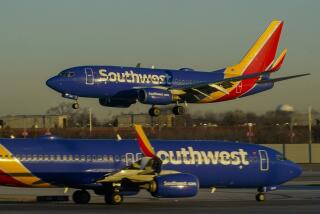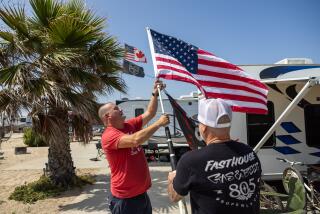Airlines offer discount fares for fall
Air travelers suffering from summer sticker shock might find some relief this fall.
With demand for air travel falling faster than Olympic swimming records, some carriers are slashing autumn fares to levels not seen since oil prices began skyrocketing last year.
“It’s a good time to fly if you want to put up with the grief,” said Joe Brancatelli, editor of the business travel website JoeSentMe.com.
In the last two weeks, for example, Southwest Airlines and JetBlue Airways began offering $49 one-way fares to the Bay Area from Southern California airports while AirTran Airways and Virgin America were selling $139 one-way tickets for flights from Los Angeles International Airport to Atlanta or New York.
“That’s good news,” said Jason Womack, an Ojai resident and management consultant who flies frequently for his job. “My clients are bracing for fares to rise.”
On Friday, Womack said he found a round-trip fare from LAX to Portland, Ore., for $400, about the same as last year. “That was a bit surprising because everything has been going up.”
International fares are still hovering at an average of 50% more than last year -- mostly because of fuel surcharges of up to $400 -- but there are signs of weakening, said Tom Parsons, chief executive of travel website BestFares.com.
Some foreign carriers began dropping prices by up to 50% last week, with round-trip fares from LAX to London dropping to about $900 from $1,600.
The latest dip in oil prices -- to $113.77 a barrel at Friday’s close from a peak of about $145 last month -- is giving airlines some room to lower fares.
But analysts and travel experts said the bargains were driven for the most part by one of the industry’s worst fears: flying planes with empty seats. Even with the latest drop in the price of oil, fuel costs are 53% more than a year ago.
“A drop of $30 a barrel helps but traffic is collapsing, so airlines are having to discount like crazy to fill their planes,” Brancatelli said.
Demand for air travel is falling faster than airlines can eliminate flights to take empty seats off line, he said. In all, domestic airlines are cutting about 10% of available seats.
“People are hesitant to spend money . . . and the concept of taking a trip on an airliner these days is not appealing, particularly with all the new fees and service cuts,” said Jack Kyser, chief economist for the Los Angeles Economic Development Corp.
Airlines typically slash fares in the fall when travel trails off after the summer vacation season. Previously, experts had said they expected fewer fare sales and smaller discounts this fall because of high fuel costs.
“I didn’t expect any fare sales, so it was surprising,” said Rick Seaney, chief executive of online travel service FareCompare.com. In the first half of the year, airlines tried to raise fares 21 times, but Seaney said there had been no such attempts in the last five weeks. “Before, we were averaging one a week,” he said. “It’s a pretty telling sign that we are close to a tipping point.”
George Hobica, founder of Airfarewatchdog.com, which also tracks airfares, said he was seeing “some astoundingly low fares.”
He recently found a flight from Cincinnati to Las Vegas for $106. “We never thought we’d see that again,” he said.
But the bargains are sporadic and not widely publicized as airlines hope to keep fares high for markets where demand is still robust or where there is little competition -- typically smaller cities with limited airline service.
The average domestic fare for fall travel is still up about 14%, or about $40 higher than last year, according to figures that travel website Travelocity is scheduled to unveil next week. Domestic round-trip tickets are averaging about $342, while international fares are averaging $749.
Although some fares are dropping, passengers shouldn’t expect the myriad new fees airlines have begun imposing on baggage, pillows, blankets and drinks to go away.
Brancatelli said that, with the exception of the controversial fee for the first checked bag, “other fees are here to stay.”
More to Read
Sign up for The Wild
We’ll help you find the best places to hike, bike and run, as well as the perfect silent spots for meditation and yoga.
You may occasionally receive promotional content from the Los Angeles Times.






